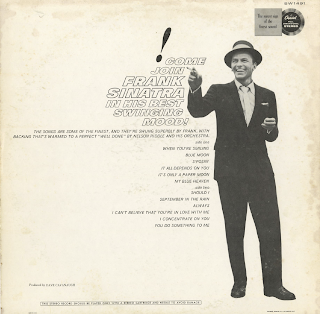Alone Together
Lonesome Gal
Lurlean Hunter
With Al Nevins and His Orchestra
Concertmaster: Harry Lookofsky
Arrangements by Marion Evans and Quincy Jones
RCA Victor LPM-1151
1956
From the back cover: Lurlean Hunter has a gift for anonymity that would frustrate the pen of a Hemingway. Possessed of a set of vocal cords capable of producing musical magic, it's the same vocal equipment that becomes strangely muted when it comes to blowing her own horn.
What she admires to is a birth date in the last twenties in Clarksdale, Miss., a move at age two months to Chicago's South Side, and a singer career that spans a decade of ups and downs in a struggle for a share of the spotlight in an era of girl singers and more girl singers.
Her career started on a dimly lit stage in Chicago's storied Club DeLisa, where Lurlean wailed above the din of "jumped up" combos. She advanced from that to vocalist on production numbers, recruiting a small but faithful band of followers in the two-and-a-half-year process.
She next moved across town to Howard Street's Club Silhouette, where Northwestern University students borrowed identification cards to spend weekends listening to Herbie Fields and "discovering" the knock-out talents of newcomer, Lurlean Hunter.
Popularity quickly growing, Miss Hunter did a stint at the Blue Note on a bill that sported George Shearing, where she acquired the inaccurate, although innocuous, title "jazz singer."
A series of club dates in and around the Windy City culminated in two years at the Streamliner where she added still more loyal followers. From the noise of that jazz spa she gyrated near-North to the intimate confines of the smart Black Orchid.
Two months at the Orchid and Lurlean moved further North on Bush Street to a subterranean cellar called the Cloister Inn where jazz has been known to hang its hat in an on-again off-again way. To the dingy, smoke-filled room below the glitter of Rush Street's neons, Lurlean sand her songs.
Not a jazz singer really, or a "song stylist," Lurlean is unique among singers of our day. Never honestly classified, hers is a voice and style that can hush a boisterous Cloister crowd with a low and throaty ballad, or raise the joint's decibel rating twenty-five percent with an up-beat rendition of a Pop standard tune.
Friendly, vocally articulate and intensely warm in personality, Lurlean Hunter is a "singer's singer" with a swinging talent that ordinary mortals can enjoy.
From Billboard - January 14, 1956: Miss Hunter long touted by jazz artists who have played Chicago, make her disk debut at long last and proves to be a richly endowed pop vocalist, but with little disk-selling personality. The standards in this set, including such as "Alone Together," "But Not For Me," etc., are arranged in conventional pop fashion, and as such lack collector appeal. The cover, carrying a striking Lena Horne-type three-quarters face shot, all stimulate some sales interest.
From Wikipedia:
In 1958, Hunter sued RCA Record Division after it used her image and her name on the cover of its "Lonesome Gal" record album (LPM-1151, 1956). The suit in United States District Court, Southern District of California, alleged "unfair competition, infringement of trade name, unfair business practices, unjust enrichment and invasion of the right of privacy." The court acknowledged that the album contained the song "Lonesome Gal", and that the use of one song's title for an album's title was common practice in the recording industry. However, it ruled in Hunter's favor on the basis that she was the first person to "adopt and establish the name Lonesome Gal as a personality" and that name was exclusively associated with her. Damages of $22,500 were awarded to Hunter, and the company was ordered to destroy all material containing Hunter's likeness in conjunction with "Lonesome Gal".
Lonesome Gal
Alone Together
It's You Or No One
You Don't Know What Love Is
You Make Me Feel So Young
My Heart And I Decided
It Never Entered My Mind
You'd Be So Nice To Come Home To
Brief Encounter
A Stranger In Town
But Not For Me
On Green Dolphin Street



























